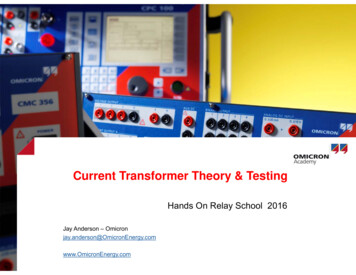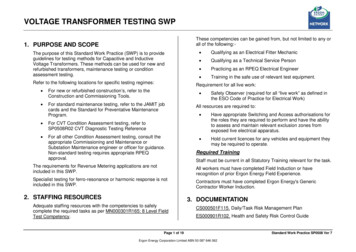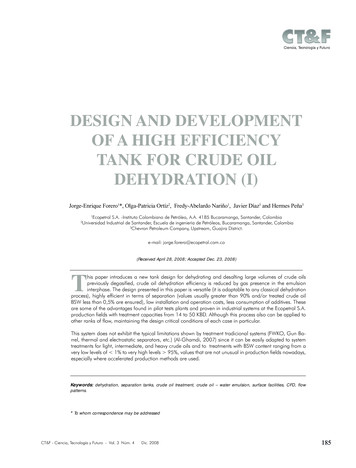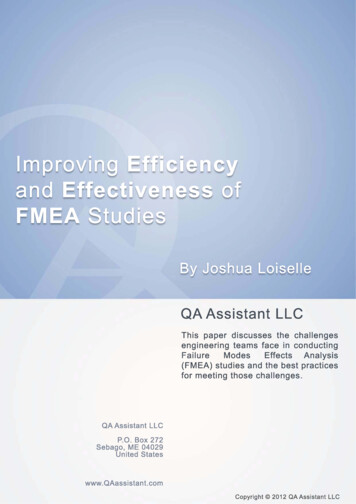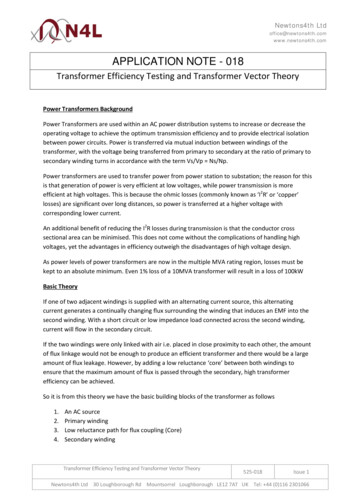
Transcription
Newtons4th ION NOTE - 018Transformer Efficiency Testing and Transformer Vector TheoryPower Transformers BackgroundPower Transformers are used within an AC power distribution systems to increase or decrease theoperating voltage to achieve the optimum transmission efficiency and to provide electrical isolationbetween power circuits. Power is transferred via mutual induction between windings of thetransformer, with the voltage being transferred from primary to secondary at the ratio of primary tosecondary winding turns in accordance with the term Vs/Vp Ns/Np.Power transformers are used to transfer power from power station to substation; the reason for thisis that generation of power is very efficient at low voltages, while power transmission is moreefficient at high voltages. This is because the ohmic losses (commonly known as ‘I2R’ or ‘copper’losses) are significant over long distances, so power is transferred at a higher voltage withcorresponding lower current.An additional benefit of reducing the I2R losses during transmission is that the conductor crosssectional area can be minimised. This does not come without the complications of handling highvoltages, yet the advantages in efficiency outweigh the disadvantages of high voltage design.As power levels of power transformers are now in the multiple MVA rating region, losses must bekept to an absolute minimum. Even 1% loss of a 10MVA transformer will result in a loss of 100kWBasic TheoryIf one of two adjacent windings is supplied with an alternating current source, this alternatingcurrent generates a continually changing flux surrounding the winding that induces an EMF into thesecond winding. With a short circuit or low impedance load connected across the second winding,current will flow in the secondary circuit.If the two windings were only linked with air i.e. placed in close proximity to each other, the amountof flux linkage would not be enough to produce an efficient transformer and there would be a largeamount of flux leakage. However, by adding a low reluctance ‘core’ between both windings toensure that the maximum amount of flux is passed through the secondary, high transformerefficiency can be achieved.So it is from this theory we have the basic building blocks of the transformer as follows1.2.3.4.An AC sourcePrimary windingLow reluctance path for flux coupling (Core)Secondary windingTransformer Efficiency Testing and Transformer Vector Theory525-018Issue 1Newtons4th Ltd 30 Loughborough Rd Mountsorrel Loughborough LE12 7AT UK Tel: 44 (0)116 2301066
Newtons4th Ltdoffice@newtons4th.comwww.newtons4th.comIdeal TransformerAn ideal transformer would exhibit zero losses, i.e. no copper loss, no core loss or stray loss. Theefficiency of this ‘ideal’ transformer would be 100% but in reality of course, this doesn’t exist forreasons that we will explain in the following text. To support the theory, we will also use a highaccuracy precision power analyzer to measure the losses in a real transformer. This will illustrate theimportance of certain aspects of transformer loss testing instrumentation and how the Newtons4thPPA5530 offers an accurate solution to this field of testing.Types of LossesCopper Loss – Copper losses would be eliminated if the windings were purely inductive, however asthe windings are by nature a very long piece of wire – this will have a resistive component and asvoltage dropped across this resistance is gives power lost as heat. This is often referred to as the I2Rloss as Power I2R.Since copper loss equates to current flow raised to the power of two, this is the dominating loss witha full load test.Eddy Current and Hysteresis losses (also known together as ‘core loss’ or ‘Iron Loss’). With a fixedprimary voltage, core loss can be considered to be constant and therefore this is the dominating losswith a no load test.Stray Loss – Primarily eddy current loss in nearby conductive materials induced from Leakageinductance (also referred to as a ‘Flux leakage’) plus skin effect losses.Magnetostriction and Mechanical Losses – Physical movement caused by the alternating magneticflux in a ferromagnetic material and alternating magnetic fields causing force between windingscause heat and sound losses. There are relatively small and are usually excluded from lossmeasurementsVectorsVector analysis is sometimes steeped in mystery, however it not as complex as it first appears andoffers a nice illustration of the behaviour of a power transformer. It enables the engineer tounderstand how each type of loss affects phase angle, impedance and efficiency of a powertransformer.Transformer Efficiency Testing and Transformer Vector Theory525-018Issue 1Newtons4th Ltd 30 Loughborough Rd Mountsorrel Loughborough LE12 7AT UK Tel: 44 (0)116 2301066
Newtons4th mer windings are effectively InductorsIt must first be understood that a winding of a transformer acts as an inductor.Fig.1As seen above, V1 is the generated voltage by the source applied to the primary winding of an idealtransformer. In the primary winding there will be a counter self EMF induced at 180 degrees to theAC source signal E2.In order to generate this counter EMF the primary winding draws current, however this current is90 lagging to the voltage source signal V1 (We will treat the primary winding as a perfect inductorfor now in this case). The below vector diagram shows Im as the primary current (remember vectorsare rotating anti-clockwise)Fig.2Transformer Efficiency Testing and Transformer Vector Theory525-018Issue 1Newtons4th Ltd 30 Loughborough Rd Mountsorrel Loughborough LE12 7AT UK Tel: 44 (0)116 2301066
Newtons4th Ltdoffice@newtons4th.comwww.newtons4th.comThis is also known as the magnetising current, i.e. it is utilised in the magnetisation of the primarycoil.The 90 phase difference is due to the following relationshipCounter EMF𝑉(𝑡) 𝐿 𝑑𝐼(𝑡) 𝑑𝑡Counter EMF often causes a mass of confusion with electrical engineers. Counter EMF is simply a“voltage drop” across the inductor, this is the same “resistance/reactance” any load presents to avoltage source in the sense that if the EMF was not in opposition to the source it would be additiveto the source voltage which we know is not the case. The difference between a resistor and aninductor is that this EMF will occur at different points in the current cycle.As you can see the instantaneous voltage across an inductor is directly proportional to the change incurrent with respect to time.Fig.3This can be explained as at 0 degrees in the current cycle the current is at its maximum change invalue with respect to time or dI/dt (passing zero degrees). If voltage is at its maximum at this timethen the voltage will be 90 degrees ahead in its waveform cycle. Therefore the current lags thevoltage by 90 degrees.This current is utilised in order to maintain the counter EMF or voltage drop across the inductor (Orwinding) and is not consumed as Watts. When the AC input signal from the grid changes polarity sodoes the counter EMF and the net effect is zero power, some engineers think of this reactive poweras sloshing forwards and backwards with no net movement over a complete cycle.This makes sense as with a phase angle of 90 degrees the power factor is Zero𝑐𝑜𝑠 cos 90 0𝑤𝑎𝑡𝑡𝑠 𝑉𝑟𝑚𝑠 𝑥 𝐼𝑟𝑚𝑠 𝑥 𝑃𝐹It is only when a resistive component is present that power will be dissipated within the winding;any power dissipated with an open secondary winding can be considered a loss in the core.Transformer Efficiency Testing and Transformer Vector Theory525-018Issue 1Newtons4th Ltd 30 Loughborough Rd Mountsorrel Loughborough LE12 7AT UK Tel: 44 (0)116 2301066
Newtons4th Ltdoffice@newtons4th.comwww.newtons4th.comWhat is Zero Power Factor?It is easy to state that “Zero power factor means that no real power is present and we have afundamental phase angle of 90 degrees, so Vrms x Irms x PF 0 WattsIt is also easy to dismiss what is actually happening with regards to current flow when a power factorof Zero is present. A simple explanation of the difference between reactive power and apparentpower is as follows. Reactive power has Zero net effect of power transfer to a component, for everyfull cycle (360 degrees) the net power transfer is Zero Watts (as previously stated). This must not bemisunderstood in thinking that no current is flowing.In an inductor, during the positive half cycle the current flow is into the inductor coil. During thenegative half cycle the current flow is “back into the source”, remember an inductor opposes currentflow) If it were a perfect inductor (Which doesn’t exist in practice as the length of wire in the coil willexhibit a finite resistance) the net effect of power will be zero.Fig.4FluxIt is the magnetising current (which is 90 behind the source voltage) that causes the alternating fluxin the core. The flux is proportional and in phase with the primary current, we can say that theprimary current and magnetising flux in the core are lagging the AC source voltage on the primary by90 . As the flux is also linked to the secondary winding – Bear in mind this is its purpose, there willalso be an EMF produced by the secondary winding - this is named “mutually induced EMF”Fig.5Transformer Efficiency Testing and Transformer Vector Theory525-018Issue 1Newtons4th Ltd 30 Loughborough Rd Mountsorrel Loughborough LE12 7AT UK Tel: 44 (0)116 2301066
Newtons4th Ltdoffice@newtons4th.comwww.newtons4th.comAs can be seen in the phasor diagram, the primary current Im is in phase with the Alternating Flux Φ,the secondary winding is placed on the same core as the primary, this winding also generates anEMF in opposition to the alternating flux. This is in phase with the primary EMF E1 which is 180 outof phase with the primary AC source voltage and 90 behind the alternating flux in the core. Thesecondary winding voltage V2 is in phase with the secondary EMF E2, in this diagram the secondary isopen circuit and no current will flow in the secondary.Core LossesCore losses are the result of Hysteresis loss and Eddy current loss, when an AC Source voltage isapplied to the primary of a transformer the primary will require a current in order to magnetize thecore, along with a current which will be used to overcome the losses in the core (Hysteresis andEddy current loss)Due to these other losses from “magnetisation of the core” The phase angle between the PrimaryVoltage and Primary Current is not 90 in a real world application as it would be in a perfecttransformer, this is due to the core loss component effectively being an in-phase or “resistive”component with respect to the primary voltage.As the core loss current is in phase with the primary voltage across the primary winding, it “drags”the current vector slightly closer to the voltage vector. So we see a phase angle between the primaryvoltage and primary current slightly less than that of a perfect inductor of 90 .During no load the primary current Io in a transformer can be denoted as follows𝐼𝑜 𝐼𝑚 𝑖𝑤𝐼𝑚 𝐼𝑜 𝑠𝑖𝑛 𝐼𝑤 𝐼𝑜 𝑐𝑜𝑠 𝐼o Im2 Iw 2Where Io Primary current, Im magnetizing current Iw Core lossTransformer Efficiency Testing and Transformer Vector Theory525-018Issue 1Newtons4th Ltd 30 Loughborough Rd Mountsorrel Loughborough LE12 7AT UK Tel: 44 (0)116 2301066
Newtons4th Ltdoffice@newtons4th.comwww.newtons4th.comThe phase diagram for this relationship is as followsFig.6As you can see, Im is typically larger than Iw and Iw is ideally as small as possible. A low value of Iw willresult in a low core loss and a no load phase angle close to 90 .Total core loss can be described with the following equationExampleTotal Core Loss (Watts) 𝑉1 𝑥 𝐼0 𝑥 𝑐𝑜𝑠 A 2400V/400V Transformer has a no load current of 1A and the core loss is 500WDetermine the following1. Power factor on the primary winding2. Core Loss Iw3. Magnetizing current ImV1 2400V V2 400V Io 1A Losses 400WCore Loss 400W V1 x I0 x cosΦ400 2400 x 1 x cosΦ400/2400 cosΦ0.1667 cosΦ Power FactorΦ 80.41 degreesTransformer Efficiency Testing and Transformer Vector Theory525-018Issue 1Newtons4th Ltd 30 Loughborough Rd Mountsorrel Loughborough LE12 7AT UK Tel: 44 (0)116 2301066
Newtons4th ing current Im I0sinΦ 1sin80.41 0.986 ACore loss component Iw I0cosΦ 1cos80.41Φ 0.1667 AOn load Phase angleWhat is interesting with regards to transformer behaviour is that the phase angle of the primary, aswell as the primary current magnitude is directly affected by the secondary load.For this example we will use a slightly inductive load on the secondary and look at the effect it hason the primary power factor. When a load is connected across the secondary winding a current I2flows, the resulting secondary emf acts to reduce the core flux. However a reduction in flux alsoreduces E1, this results in an increased primary current I’1 (balancing current) giving a restored mmf(magnetomotive force). It is important to remember that mmf remains constant on both the primaryand the secondary.Fig.7Transformer Efficiency Testing and Transformer Vector Theory525-018Issue 1Newtons4th Ltd 30 Loughborough Rd Mountsorrel Loughborough LE12 7AT UK Tel: 44 (0)116 2301066
Newtons4th Ltdoffice@newtons4th.comwww.newtons4th.comA 2:1 Step down Transformer is supplied with 240Vrms and has a no load current of 5A with a powerfactor of 0.087 lagging. If a load with an impedance of 2.4Ω is connected to the secondary with aresultant power factor of 0.97 with respect to the secondary voltage we can then calculate theexpected power factor on the primary and the primary current.Calculate secondary voltage𝑁𝑝 𝑉𝑝 𝑁𝑠 𝑉𝑠2 240 𝑉𝑠1𝑉𝑠 120𝑉𝑟𝑚𝑠Secondary CurrentSecondary current Phase Angle𝐼2 𝑉 50𝐴𝑟𝑚𝑠𝑅cos 1 0.97 14.06 𝑑𝑒𝑔𝑟𝑒𝑒𝑠As this is a step down transformer the current on the primary will be a product of the followingequation𝐼𝑝 𝑉𝑠 𝐼𝑠 𝑉𝑝𝐼𝑝 120 50 240120𝐼𝑝 𝑥 50 25𝐴𝑟𝑚𝑠240As we know the mmf is equal and opposite on the primary to the secondary which is a product ofthe voltage and current vectors, therefore the “balancing current” to maintain the flux on theprimary required is also the same phase angle from V1 as I2 is from V2From this we know that the primary “balancing current” is 25A at a phase angle of 14.06 degreeslagging.In order to calculate the primary power factor and total primary current we must add the balancingcurrent and off load current Io together vectorially.We do this by adding the in phase and quadrature components of both vectors together as follows𝐼0 5𝐴 5 ��𝑎𝑙 𝐶𝑜𝑚𝑝𝑜𝑛𝑒𝑛𝑡 5𝑠𝑖𝑛5 0.436Transformer Efficiency Testing and Transformer Vector Theory525-018Issue 1Newtons4th Ltd 30 Loughborough Rd Mountsorrel Loughborough LE12 7AT UK Tel: 44 (0)116 2301066
Newtons4th 𝑟𝑖𝑧𝑜𝑛𝑡𝑎𝑙 𝐶𝑜𝑚𝑝𝑜𝑛𝑒𝑛𝑡 5𝑐𝑜𝑠5 4.981𝐼′2 25𝐴 (90 14.06) ��𝑎𝑙 𝐶𝑜𝑚𝑝𝑜𝑛𝑒𝑛𝑡 25𝑠𝑖𝑛75.94 24.251𝐻𝑜𝑟𝑖𝑧𝑜𝑛𝑡𝑎𝑙 𝐶𝑜𝑚𝑝𝑜𝑛𝑒𝑛𝑡 25𝑐𝑜𝑠75.94 6.073We can add the vertical components and horizontal components to find the primary current I1 usingPythagoras theorem𝐼1 (0.436 24.251)2 (4.981 6.073)2𝐼1 24.6872 11.0542𝐼1 27.049𝐴𝑟𝑚𝑠The resultant phase angle once the influence of the no-load current vector is accounted for can becalculated as follows𝑡𝑎𝑛 𝑝𝑟𝑖𝑚 24.68711.054 𝑝𝑟𝑖𝑚 65.879This phase angle is taken with respect to the horizontal; we must convert this to be with respect tothe vertical V1 𝑝𝑟𝑖𝑚 90 65.879 24.121 𝑑𝑒𝑔𝑟𝑒𝑒𝑠If we remember the secondary phase angle was 14 degrees. We can see that although the primary“balancing current” is exactly 180 degrees out of phase with the secondary current, the resultantprimary current vector includes the no-load magnetizing current and core loss components.It is not correct to assume that the impedance seen on the primary is a mirror image of theimpedance connected across the secondary. The losses in the primary and magnetizing current mustbe known in order to subtract them from the on-load phase angle and magnitudes.Transformer Efficiency Testing and Transformer Vector Theory525-018Issue 1Newtons4th Ltd 30 Loughborough Rd Mountsorrel Loughborough LE12 7AT UK Tel: 44 (0)116 2301066
Newtons4th mer power factor and efficiency testing with the N4L PPA5530 Power AnalyzerA 1:1 isolation transformer was tested and the results are shown in the following text, no load andmax load tests were performed, short circuit tests were not carried out at this time.Fig.8At a mains voltage of 235.83V (fundamental 50.025Hz) and 41.796 watts the transformer has aprimary off load phase angle of -77.11 degrees. This is the phase angle between V1 and I0The calculated impedance at the fundamental frequency of 50.025Hz is as follows235.83V / 794.49mA 296.83ΩThis is confirmed in the Impedance Analyzer mode on the N4L PPA5530.Fig.9In order to obtain a visual representation of the PPA5530 Precision Power Analyzer’s results,especially for those of us who are unfamiliar with power analyzer numerical displays which offer farmore resolution than a vector display. We will convert the figures into a vector diagram to help withinterpretation of the results. It must be noted that trying to read such phase angle criticalTransformer Efficiency Testing and Transformer Vector Theory525-018Issue 1Newtons4th Ltd 30 Loughborough Rd Mountsorrel Loughborough LE12 7AT UK Tel: 44 (0)116 2301066
Newtons4th ents from a vector diagram is the incorrect approach and the PPA5530 offers a numericrepresentation of the phase angles.Note that the display will show the “fundamental impedance” This is the impedance of thetransformer winding at the fundamental frequency of 50.025Hz.Here we can see V1 the primary voltage from the grid, I0 is the off load current. This includes themagnetizing current and Core losses.We can calculate the losses with just the primary voltage, off load current magnitude and the phaseangle between the two.We then use trigonometry to calculate the in phase current component (the losses) and multiply thisby the Voltage which will give us the power in Watts. Using an N4L PPA5530 Precision PowerAnalyzer, all of these calculations are performed within the instrument.This provides a good understanding of what power really is; it is the “in phase” current componentproviding “real” power i.e. Heat Loss.Transformer Efficiency Testing and Transformer Vector Theory525-018Issue 1Newtons4th Ltd 30 Loughborough Rd Mountsorrel Loughborough LE12 7AT UK Tel: 44 (0)116 2301066
Newtons4th Ltdoffice@newtons4th.comwww.newtons4th.comAs you will now be able to see, the more Hysteresis and Eddy Current loss that exists in the core, thegreater the in phase component will be.Magnetizing Current𝐼𝑚 0.79449𝑠𝑖𝑛77.11Core loss component𝐼𝑚 0.774𝐴𝐼𝑐 0.79449𝑐𝑜𝑠77.11𝐼𝑐 0.177𝐴If we multiply the “In phase” core loss component with the fundamental voltage, we have the power𝐿𝑜𝑠𝑠 (𝑊𝑎𝑡𝑡𝑠) 𝑉 𝑥 𝐼𝑚𝐿𝑜𝑠𝑠 235.83 𝑥 0.177 41.74𝑊Although there is a small rounding error in comparison with the correct figure shown on thePPA5530, you can see the figure does correlate with the watts measurement in figure 8.Transformer Efficiency Testing and Transformer Vector Theory525-018Issue 1Newtons4th Ltd 30 Loughborough Rd Mountsorrel Loughborough LE12 7AT UK Tel: 44 (0)116 2301066
Newtons4th Ltdoffice@newtons4th.comwww.newtons4th.comHarmonic AnalysisThe N4L PPA5530 Power analyzer includes a Harmonic Analysis mode. As can be seen in thescreenshot below, the voltage waveform has a small amount of distortion. (Expected of a mainswaveform) interestingly the current waveform is quite heavily distorted.This is confirmed with the Oscilloscope mode belowAs seen, the current waveform is almost triangular, this likely to be a result of the manufacturerusing the minimum amount of core material possible in order to save costs. We can also see anapproximate deltaT of 4.400ms between the current and voltage waveforms, this relates to the11.09 degree phase angle.Transformer Efficiency Testing and Transformer Vector Theory525-018Issue 1Newtons4th Ltd 30 Loughborough Rd Mountsorrel Loughborough LE12 7AT UK Tel: 44 (0)116 2301066
Newtons4th Ltdoffice@newtons4th.comwww.newtons4th.comOn Load testingAs illustrated in figure 7 the impedance presented on the secondary winding is reflected onto theprimary (taking into account core loss compoments). In this test a resistive heater was connected tothe secondary, this load has a power factor close to unity. We will see this reflected back onto theprimary and the current vector will be “pulled” closer to the mains voltage vector, this is a result ofthe in-phase vector presented on the secondary tending to reduce the core flux which causes anincrease in the primary current which will be 180 degrees out of phase with this secondary currentbut in phase with the primary voltage.On load Primary Winding - N4L PPA5530 Power Analyzer readingsNow we have 1.4868kW, 6.5169A current and a power factor of 0.9811 (-11.09 phase angle)It must be noted that this is not quite a full load test, the transformer under test was a 1.5kVAtransformer and we are testing at 1.4868kVA. In order to draw a complete vector diagram we cannow test the secondary output, once the results are obtained we can now verify the theory that theimpedance, the current and its respective phase angle in relation to the secondary voltage isreflected back onto the primary 180 degrees out of phase. We will also see the effect of thesecondary current and its effect on the primary winding phase angle and power factor.Transformer Efficiency Testing and Transformer Vector Theory525-018Issue 1Newtons4th Ltd 30 Loughborough Rd Mountsorrel Loughborough LE12 7AT UK Tel: 44 (0)116 2301066
Newtons4th y Winding N4L PPA5530 Power analyzer ReadingsThere is a notable difference in the two voltages on the primary and the secondary. We can see avoltage of 232.61V on the primary and 227.76V across the secondary; this is due to the voltage dropacross the impedance of the secondary windings of which consists of the resistance of the windingsand the leakage reactance of the windings. We have not drawn the vector components of thisimpedance for simplicity but it must be taken into account.The following equations describe the relationship between the Input Voltage V1 and the outputvoltage V2𝑉1 𝐸1 𝐼1𝑅1𝑉2 𝐸2 𝐼2𝑅2Transformer Efficiency Testing and Transformer Vector Theory525-018Issue 1Newtons4th Ltd 30 Loughborough Rd Mountsorrel Loughborough LE12 7AT UK Tel: 44 (0)116 2301066
Newtons4th Ltdoffice@newtons4th.comwww.newtons4th.comOn load Vector diagram (simplified) for 1:1 Isolation transformerAs seen above, we can now visualise the effect that the load presented on the secondary windingwill have on the input current and phase angle (or power factor) on the primary. These figures willinclude the core losses and copper losses discussed previously.Transformer Efficiency Testing and Transformer Vector Theory525-018Issue 1Newtons4th Ltd 30 Loughborough Rd Mountsorrel Loughborough LE12 7AT UK Tel: 44 (0)116 2301066
Newtons4th cy TestingTest SetupFor 3 Phase transformers two N4L PPA5530 can be used in a master slave configuration for 6 phaseanalysis. This test was performed on a single phase transformer and the heat was set to maximum.Instrument SetupEfficiency is enabled in the Power menu and phase/next phase is selected, the input to thetransformer was then connected to Phase 2 of the power analyzer and the output was connected toPhase 3, Phase 1 was not used during this test as the testing fixture was on the side of theinstrument phase 3 is located.1:1 Isolation Transformer Efficiency test resultsTransformer Efficiency Testing and Transformer Vector Theory525-018Issue 1Newtons4th Ltd 30 Loughborough Rd Mountsorrel Loughborough LE12 7AT UK Tel: 44 (0)116 2301066
Newtons4th Ltdoffice@newtons4th.comwww.newtons4th.comAs seen above a result of 93% efficiency was recordedThe PPA55xx series of power analyzers provide excellent phase angle accuracy of 0.005 degrees, thisoffers an excellent solution for low power factor (Open secondary) core loss tests.For more information regarding the Newtons4th (N4L) Precision Power Analyzers please visitwww.newtons4th.comTransformer Efficiency Testing and Transformer Vector Theory525-018Issue 1Newtons4th Ltd 30 Loughborough Rd Mountsorrel Loughborough LE12 7AT UK Tel: 44 (0)116 2301066
Transformer Efficiency Testing and Transformer Vector Theory 525-018 Issue 1 Newtons4th Ltd 30 Loughborough Rd Mountsorrel Loughborough LE12 7AT UK Tel: 44 (0)116 2301066 This is also known as the magnetising current, i.e

